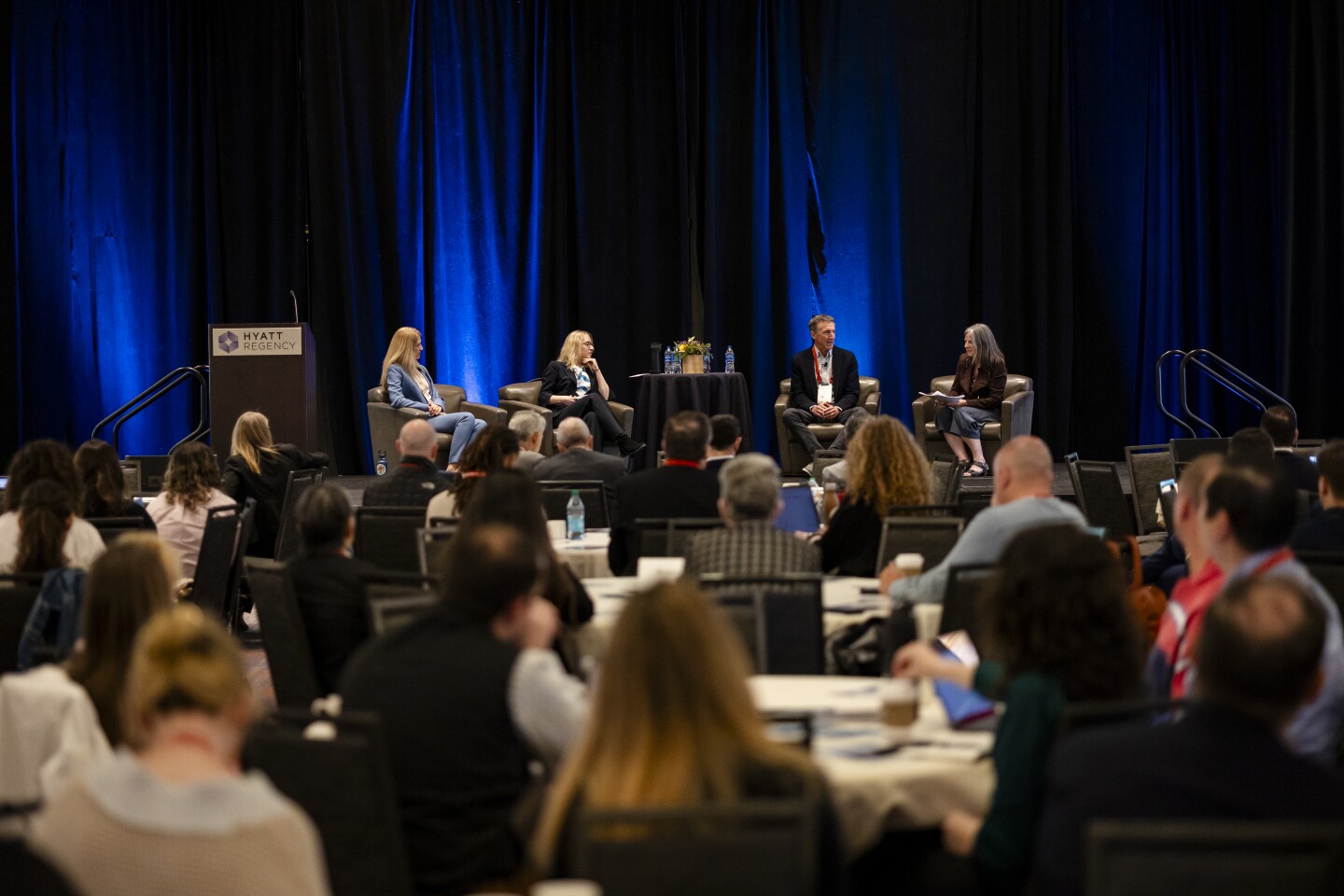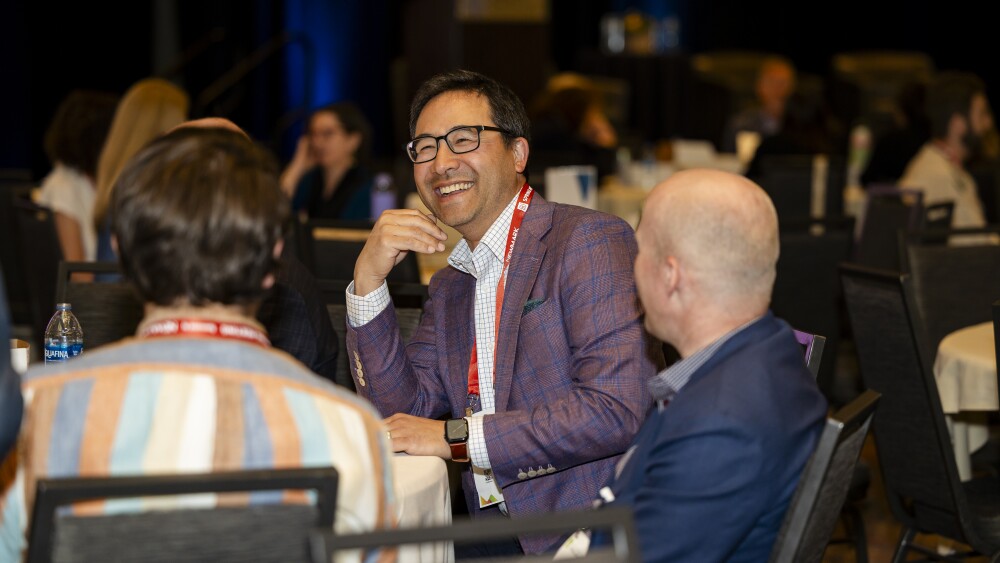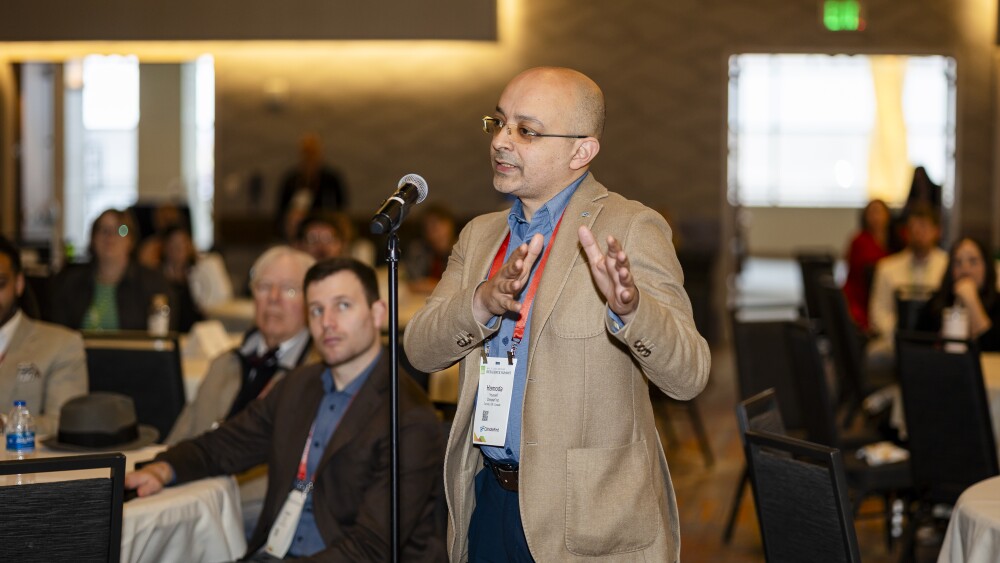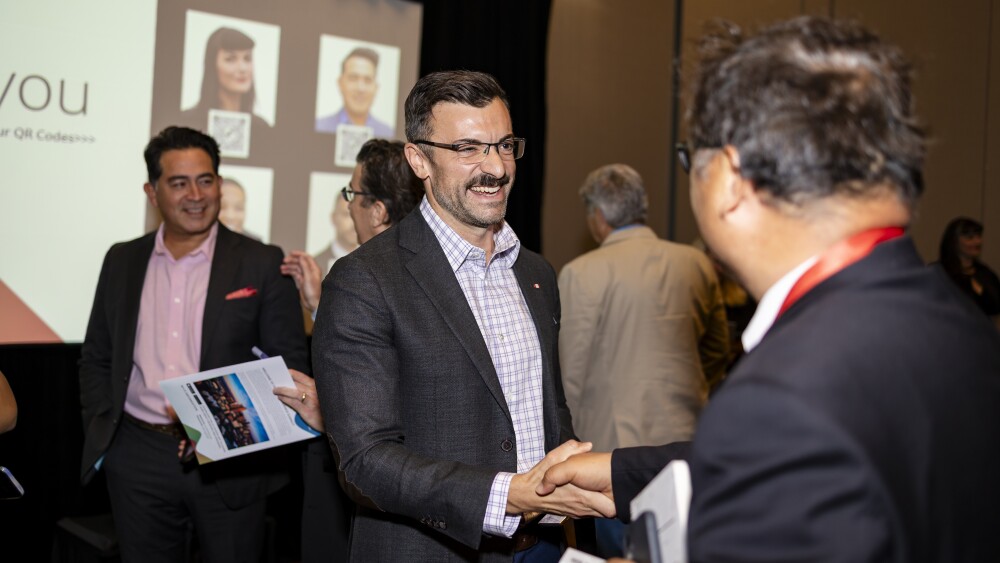
The panel titled “Preventing the Next Palisades Disaster—Learning from Colorado Wildfires,” moderated by Molly McCabe, CEO of HaydenTanner, featured Anne Miller, director of the Colorado Resiliency Office; Molly Mowery, executive director of the Community Wildfire Planning Center; and Joe Loidolt, president of Classic Homes.
ULI
Without climate adaptation, large corporations could face $1.2 trillion in annual losses by 2050, according to Lindsay Brugger, vice president of the Urban Resilience program at ULI’s Randall Lewis Center for Sustainability in Real Estate. Brugger delivered opening remarks at ULI’s sixth annual Resilience Summit on May 15 in Denver where more than 300 attendees gathered at the Hyatt to explore resilience and recovery locally and elsewhere.
“Here in the U.S., we’re lucky,” Brugger said. “We’re lucky to have agencies like NOAA and NASA who provide freely available climate data to the public that enables not only individuals to take action, but [also] companies like climate risk analytic service providers and expert consultants to advise the real estate industry and our city leaders on their physical climate risks,” she said. “Scientists tell us that the physical impacts of climate change are accelerating far more quickly than anticipated, which means this data is more important than ever, particularly as we make daily decisions that will echo throughout our cities and our portfolios for decades.”
Brugger noted that back-to-back hurricanes in 2024—Helene and Milton—caused catastrophic flooding, resulting in more than $100 billion of damage and leaving millions without power. Elsewhere, Spain experienced a year’s worth of rain in just a few hours, and China faced devastating floods that led to $32 billion in losses. As 2025 began, wildfires raged across Los Angeles, underscoring our urgent need to address climate hazards.
Although these events paint a dire picture, Brugger explained, it is essential to recognize that “the risk of disaster lies at the intersection of exposure and vulnerability.” Communities do not have to let these hazards become disasters. By choosing safer sites for development and addressing physical climate risk, exposure and vulnerability can be significantly reduced, she said.
Funding is crucial for translating plans into reality, but proactive federal investment has stalled, jeopardizing the vitality of communities, according to Brugger. She noted that the Resilience Summit aims to accelerate adaptation action and foster innovation and collaboration among all stakeholders.“Here in the U.S., we’re lucky,” Brugger said. “We’re lucky to have agencies like NOAA and NASA who provide freely available climate data to the public that enables not only individuals to take action, but [also] companies like climate risk analytic service providers and expert consultants to advise the real estate industry and our city leaders on their physical climate risks,” she said. “Scientists tell us that the physical impacts of climate change are accelerating far more quickly than anticipated, which means this data is more important than ever, particularly as we make daily decisions that will echo throughout our cities and our portfolios for decades.”
Brugger noted that back-to-back hurricanes—Helene and Milton—caused catastrophic flooding, resulting in more than $100 billion of damage and leaving millions without power. Elsewhere, Spain experienced a year’s worth of rain in just a few hours, and China faced devastating floods that led to $32 billion in losses. As 2025 began, wildfires raged across Los Angeles, underscoring our urgent need to address climate hazards.
Although these events paint a dire picture, Brugger explained, it is essential to recognize that “the risk of disaster lies at the intersection of exposure and vulnerability.” Communities do not have to let these hazards become disasters. By choosing safer sites for development and addressing physical climate risk, exposure and vulnerability can be significantly reduced, she said.
Funding is crucial for translating plans into reality, but proactive federal investment has stalled, jeopardizing the vitality of communities, according to Brugger. She noted that the Resilience Summit aims to accelerate adaptation action and foster innovation and collaboration among all stakeholders
Leveraging strengths
Rodney Milton, executive director of ULI Colorado, welcomed attendees to the state, noting that the Institute is not just about understanding challenges created by climate change but also about “mapping the levers of power that allow us to create change. And it’s in that vein that I really think about the role that ULI plays.”
As an example, Milton pointed to ULI’s 2019 Technical Advisory Panel for Evergreen, Colorado, whose downtown lies within a floodplain. He also pointed to ULI’s 2023 Advisory Services Panel on the Marshall Fire.
“If you look at the [Project Recovery report] work that was done in L.A., you can see . . . the capacity that ULI brings to the table,” Milton said. “We need to make sure that we leverage our strengths—which are often you, your expertise, your willingness to dive in and apply our multidisciplinary approach to the challenges that we face.” Echoing his remarks, the opening panel examined Colorado’s cross-sector approach to wildfire recovery and resilience.
Learning from Colorado Wildfires
The panel titled “Preventing the Next Palisades Disaster—Learning from Colorado Wildfires,” moderated by Molly McCabe, CEO of HaydenTanner, featured Anne Miller, director of the Colorado Resiliency Office; Molly Mowery, executive director of the Community Wildfire Planning Center; and Joe Loidolt, president of Classic Homes.
Miller opened with a historical summary of Colorado’s wildfires, noting that the state experienced its 20 largest wildfires in the last 25 years, with three occurring in 2020, during the pandemic. She highlighted the Marshall Fire, which struck the Boulder area on December 30, 2021, destroying 1,084 homes in just one day, due to high winds. Miller emphasized the urgency for state and local government action, stating, “These huge disasters have been a wake-up call.”
In response to wildfire trends, the Colorado governor’s administration has prioritized wildfire management, catalyzed by the Marshall Fire. Key initiatives include the 2021 establishment of the Natural Disaster Mitigation Enterprise, a 2022 bill aimed at incentivizing resilient rebuilding, and, in 2023, the Wildfire Resiliency Code Board.
Loidolt, representing the building industry, shared insights from his experience with past wildfires—specifically the Waldo Canyon Fire and the Black Forest Fire. He emphasized the need to balance wildfire resilience/safety against affordability when developing new code requirements so that the code requirements are embraced and executed.
The panel addressed the dual crises of housing demand and wildfire risks. McCabe highlighted potential safe development areas despite high-risk zones. Miller advocated for a comprehensive resilience strategy, stating, “Some of the key principles of resilience are really around solving multiple problems at the same time, taking a systems approach.”
Project Recovery
ULI Americas CEO Mary Beth Corrigan then introduced Claire de Briere, a longtime member of ULI and former Chair of the District Council for ULI Los Angeles, who currently serves on the Institute’s Global Board of Directors. De Briere played a key role in the ULI initiative to create a comprehensive roadmap for recovery and rebuilding in Los Angeles, all within a few weeks.
De Briere recounted receiving texts on the morning after the start of the January fires in L.A. The texts came from former ULI Los Angeles District Chair Kevin Zoryan and current ULI Los Angeles District Council Executive Director Kellie Koa Miles. De Briere said, “They asked, ‘What are we going to do? What can we do?’ Because that’s what ULI does. We take action.”
The fires occurred on a Tuesday. De Briere noted that by the following Friday, ULI Los Angeles convened a governance committee meeting to discuss options—particularly around insurance, financing, and rebuilding. Within a couple of weeks, De Briere said, the group had a working draft of the 175-page Project Recovery report, a living document developed by ULI Los Angeles, UCLA, and USC that provides expert recommendations to expedite fire recovery.
Attendees, inspired by the morning’s remarks, spent the remainder of the day exploring innovative approaches to protect cities and portfolios.

The “Climate Risk Management: Evolving Approaches to Reducing Asset and Portfolio Climate Risk” panel feature Ross Beardsley, senior managing consultant at Ramboll; Gretchen Hancock, managing director at BlackRock (formerly under Global Infrastructure Partners); Reid Morgan, Americas-focused member relations manager, at GRESB; Kimberly Pexton, senior vice president, sustainability, JGB Smith Properties; and Katie Wholey, director of community resilience at Enterprise Community Partners.
ULI
Strategies for assessing and mitigating climate risks
· “Climate Risk Management: Evolving Approaches to Reducing Asset and Portfolio Climate Risk” featured panelists Ross Beardsley, senior managing consultant at Ramboll; Gretchen Hancock, managing director at BlackRock; Reid Morgan, Americas-focused member relations manager for GRESB; Kimberly Pexton, senior vice president, sustainability at JBG Smith Properties; John Thigpen, vice president, sustainability services at JLL; and Katie Wholey, director, community resilience and climate at Enterprise Community Partners. They discussed strategies for factoring physical climate risk data and resilience measures into asset management plans and capital expenditure cycles.
· “Where Science Meets Design: Using Climate Projections in Portfolio and Land Use Planning” featured experts Ariane Laxo, director of sustainability at HGA; Ashley Muse, founder of Muse Design & Consulting; Amanda Farris, associate director of the Climate Adaptation Partnership at the University of Minnesota; and Richard Graves, director of the Center for Sustainable Building Research and College of Design at the University of Minnesota. Laxo explained that “our sustainability modeling, our energy modeling, is using outdated information, and there’s inherent risk in that.” In response, the panel discussed a process for using localized, future-facing climate projections in planning to enhance decision-making around sustainable buildings and infrastructure, aligning with financial goals.
Creating climate-ready housing
· “From Crisis to Opportunity: Affordable Housing as a Climate Solution in the US and Canada,” moderated by Brandy Burdeniuk, director of ESG, North America of Avison Young, featured Dez Edwards, SVP of Urban Pulse Commercial Group; Ozzie Gonzalez, owner of P3 Consulting; and Ryan Rizzo, CEO & founder, Mantle Developments. The panel discussed innovative approaches to tackle housing challenges while combating climate change. They showcased such projects as one in Atlanta called The Melody, which uses repurposed shipping containers for the unhoused, and the Hollywood Transit Hub in Portland, which includes 222 affordable units. The panel emphasized modular construction, low-carbon materials, and energy-efficient systems, as well as transit-rich sites and community-centered design as hallmarks of equitable, climate-ready housing.
· “Insurance for Affordable Housing: How Resilient Construction Can Improve Insurability and Preserve Housing Supply,” moderated by Graham Green, communications director at Smart Growth America, addressed affordable housing challenges in disaster-prone areas. Panelists were Manuela Ekowo, public policy associate at the Insurance Institute for Business and Home Safety; Asher Kripke, community and economic development product manager at the Federal Home Loan Bank of Dallas; Kathy Laborde, president & CEO of Gulf Coast Housing Partnership Inc.; and Pete Romano, EVP and North America real estate industry leader at Aon. They discussed the impacts of natural disasters on housing and the importance of resilient construction methods such as the FORTIFIED standard. Insights from this panel appear in this Urban Land magazine article.
The role of public policy in fostering climate-prepared development
· “Out of Harm’s Way: Practical Strategies for Managed Retreat,” led by Hannah Glosser, director at HR&A Advisors, featured Marissa Aho, director of executive climate office at King County, Washington; Alison Branco, director of climate adaptation at The Nature Conservancy in New York; and Despo Thoma, director of resilience at Scape Landscape Architecture. They stressed managed retreat as an essential tool for climate adaptation, noting that relocating a million flood-prone properties could save more than $1 trillion. Insights from this panel appear in this Smart Cities Dive article.

“Where Science Meets Design: Using Climate Projections in Portfolio and Land Use Planning” featured experts Ariane Laxo, director of sustainability at HGA; Ashley Muse, founder of Muse Design & Consulting; Amanda Farris, associate director of the Climate Adaptation Partnership at the University of Minnesota; and Richard Graves, director of the Center for Sustainable Building Research and College of Design at the University of Minnesota.
ULI
· “Resilient by Regulation: How Texas’s New Rules are Preparing Mixed-Use Campuses for Bigger Storms,” moderated by Bill Kenworthy, principal and northeast practice leader for urban design at HOK, featured panelists Nicole Boudreau, director at Hines, and Zachary Christeson, principal and Texas regional leader of planning at HOK. The discussion focused on how Houston developers are enhancing flood resilience through innovative design and collaboration with city regulations.
The panelists highlighted two projects: a Fortune 1000 company’s headquarters and the Levit Green life sciences district, which employed strategies such as flood-tolerant parking structures, relocating of storm sewers, and low-impact development techniques that mitigate flood risks and enhance community spaces. Panelists addressed challenges from Houston’s proliferating flood events, including multiple 500-year floods. They showcased how developers can navigate strict city regulations by consolidating detention areas, using natural drainage systems, and designing adaptable spaces for rising water levels.
“Shoring Up the Future: Policies and Plans Advancing Resilience in the Bay Area and Beyond,” led by Brooke DuBose, associate principal of resilience and transportation at ARUP, featured Dana Brechwald, assistant planning director for climate adaptation for SF Bay Conservation and Development; Summer Bundy, director of project management and OneShoreline at San Mateo County; Mikaela Hiatt, associate transportation planner at the Transportation Authority of Marin; and Janelle Kellman, founder and CEO at Center for Sea Rise Solutions. The session covered several case studies of advancing resilience in the San Francisco Bay Area, highlighting the impact of rising sea levels and extreme weather events.
DuBose introduced SB 272, which mandates local adaptation plans by 2034, and the $96 billion needed for adaptation by 2050, of which only $6 billion is currently identified. Brechwald discussed Bay Conservation and Development’s role in sea level rise planning. Kelman shared Sausalito’s challenges, emphasizing community engagement, technical capacity, and political will. Bundy detailed San Mateo County’s OneShoreline initiative, focusing on policy guidance and funding. Hiatt discussed Marin County’s transportation adaptation efforts, including a $300,000 budget for sea level rise projects. The discussion also focused on proactive planning for sea level rise and flooding, emphasizing the need for a unified approach. Key points included the importance of community involvement and the use of adaptation pathways.
The OneShoreline initiative was highlighted for its role in facilitating projects and bridging state and federal agencies. The conversation also touched on the scalability of the model, the potential for insurance as a funding source, and the challenges of securing funding, with examples of local tax measures and state-level efforts. The goal is to integrate adaptation into capital improvement programs and governance structures. “Our agency was initially envisioned to help advance shoreline adaptation projects,” Bundy said. “We did an analysis of over a dozen local proposals to comply with the state regional housing needs allocations and found that 43 percent of the proposed units were in the current or future floodplain, and 38 percent of affordable units were in these areas. Projects like [these] are not only putting the infrastructure investments at risk, but they’re also leaving us very limited space to implement shoreline adaptation projects, and so these drivers prompted us to develop a planning policy guidance.”
Funding and financing resilient communities
· “Resilience in Denver: Water, Equity, and Funding Strategies in the Mile-High City,” moderated by Liz Babcock, executive director of the Office of Climate Action, Sustainability, and Resiliency for the City and County of Denver, featured Jolon Clark, executive director of Denver Parks and Recreation; Ashlee Grace, director of Denver’s Waterway Resiliency Program; and Nita Gonzalez, principal of Nuevo Amanecer and cofounder of River Sisters Congreso, who discussed Denver’s resilience efforts. The panelists highlighted the establishment of the Parks Legacy Fund, which generates more than $100 million annually for Denver Parks and Recreation; the Climate Protection Fund sales tax measure, which raises $50 million annually for climate action; and the Waterway Resiliency Program, which aims to restore the South Platte River to mitigate flood risks and create vibrant spaces in partnership with local communities and other partners such as River Sisters. Reflecting on these funding sources and the projects and partnerships they enable, Babcock said, “There was a demand for the next generation of climate action and resilience.”
· In the session titled “Financing Resilience at the State and Local Level: Innovations from Massachusetts and Boston,” moderator Catherine McCandless, senior climate resilience project manager for the Office of Climate Resilience, City of Boston, led a discussion with panelists Deanna Moran, chief coastal resilience officer at the Massachusetts Office of Coastal Zone Management, and Mia Mansfield, assistant secretary for resilience at the Massachusetts Executive Office of Energy & Environmental Affairs. They cited Boston’s proactive strategies since 2016 to promote climate-resilient infrastructure through public/private partnerships and diverse funding mechanisms, such as a state revolving loan fund, as well as the importance of prioritizing projects to maximize the impact of limited funding. Moran said, “The ResilientCoasts Initiative has culminated in a first-ever 50-year resilient coast plan for the state. The plan informs prioritization . . . and includes coastal typologies and best practices.” She highlighted the value of coordinated planning.
The day culminated in a fireside chat with Joyce Coffee, president, Climate Resilience Consulting, and Jay Sholl, senior vice president, CBRE. They discussed the evolving landscape of adaptation finance, investment, and funding.
Beginning with a reflection on how the financial landscape around climate adaptation is changing, Coffee highlighted the growing costs of property insurance as an important risk signal. Sholl concurred, adding that human beings are often slow to change behavior, and those who are self-insuring are quickly seeing the benefit of enhanced resilience and sites with lower hazard exposure.

Resilience Summit closing keynote, titled “Resilience Summit Closing Fireside Chat: The Cost of Change a Path Forward,” featured Joyce Coffee, founder and president of Climate Resilience Consulting and Jay Sholl, senior vice president at CBRE and examined the future of adaptation finance, investment, and funding in a changed landscape.
ULI
Given this growing risk, Coffee pointed out that investors increasingly realize how “short-term accounting hides long-term risk. Calculating values that reflect durability, disruption avoidance, and social benefits properly values the new and increasing adaptation investment class.” ESG investors, sustainability bonds, green bonds, and “resilient-curious” REITs are all beginning to recognize this overlap and are directing their capital accordingly.
Beyond individual assets and portfolios, Coffee noted that infrastructure is “the foundation of resilience in our communities.” Public/private partnerships—the Chicago Metropolitan Water Reclamation District’s Deep Tunnel program, for example—were identified as one way that large-scale resilient infrastructure initiatives are being implemented. The Tunnel, which reduces household flooding, does not rely on federal funds. Instead, it was paid for through a state revolving loan fund and rate payer fees that were bolstered by a consent decree facilitating future rate increases.
As the conversation came to a close, Coffee reminded attendees that “resilience isn’t a sunk cost—it’s a strategic asset.” She encouraged leaders to be honest about risk when they ask themselves, “‘Can this property still thrive in 2035?’”
The annual ULI Resilience Summit brings together private and public sector leaders in resilience and real estate to catalyze adaptation action across the globe. The 2025 event was generously supported by executive vice president of the Lewis Group of Companies, Randall Lewis, EastWest Partners, and HKS.
Please join us for the 2026 Resilience Summit, which will be held during ULI’s Spring Meeting in Nashville, Tennessee, continuing the momentum and advancing the dialogue on urban resilience and climate adaptation strategies within the real estate industry.








